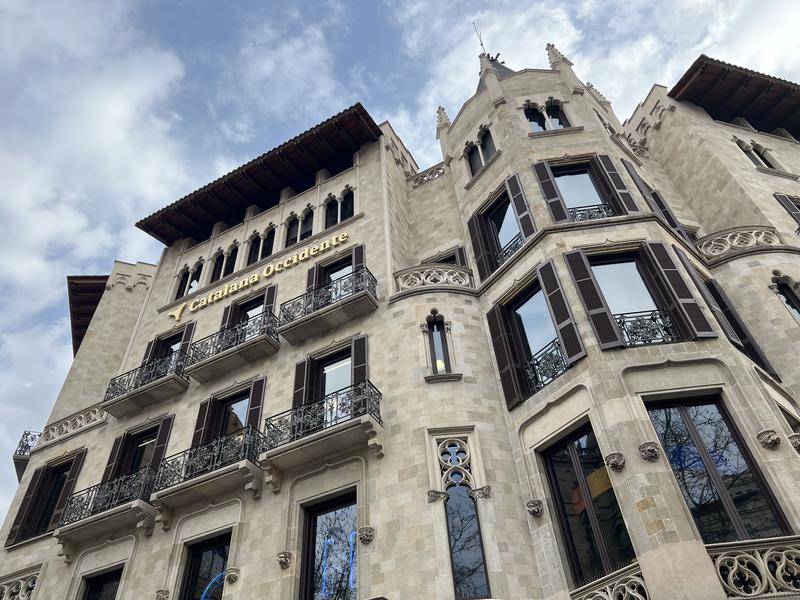Transforming 19th-century modernisme art nouveau masterpiece building into offices
Architect Enric Sagnier’s Casa Pascual i Pons on Barcelona's Passeig de Gràcia is home to Apple

Spending a Tuesday morning in the 19th century is quite difficult nowadays, but traveling back in time in Barcelona’s city center is still possible, or at least that is what it feels like when walking around 'Casa Pascual i Pons.'
Catalan modernisme art nouveau architect Enric Sagnier supervised the construction of this masterpiece between 1890 and 1891. It is located at 2-4 Passeig de Gràcia boulevard where it meets Plaça de Catalunya square.
At the time, it hosted tenants and the building's owners: the Pascual and Pons families. Now, over a century later, it is home to one of the largest international companies, Apple, and the French Chamber of Commerce in Spain.
The families "were quite modern back then as they rented the apartments and did not sell them," as was more common, Miquel Espinet, the head of the studio named after him, Espinet+Ubach, told Catalan News.

This architecture studio has been behind this years-long refurbishment project, taking three years of planning and five years of works. The building is legally considered to be part of Barcelona's heritage, meaning any works require licenses and must follow many guidelines.
"The biggest challenge was transforming this building into one from the 21st century keeping and highlighting the most important heritage parts," the architect said to this media outlet.

"This is the challenge, or at least the goal of this refurbishment," he added when discussing the neo-Gothic modernism building.
Not first refurbishment
'Casa Pascual i Pons' already experienced a major refurbishment between 1982 and 1984. At the time, the project was led by the famous late architect Oriol Bohigas and his team and Espinet+Ubach.
Bohigas, known for opening the Catalan capital up to the sea with his vision for the Olympic village neighborhood, and considered the father of modern Barcelona, passed away on December 1, 2021.
Both studios worked together to add a sixth floor to the building. Decades later, however, the construction work included a five-floor underground parking lot, and the restoration of craftsmanship pieces and the façade.

"One of the most important elements of the building is the façade facing Passeig de Gràcia boulevard, Casp street, and Ronda Sant Pere boulevard," Espinet said to Catalan News.
For him, the façade "is extraordinary," as it has "two towers that mark the borders of Passeig de Gràcia."
The craftsmanship pieces were either restored or made anew if the original was missing. An example is seen on the first floor, where there are several stained glass windows, all of them with a religious figure, such as Sant Jordi (or Saint George) with his dragon painted.
All, except one, as it was impossible to recover, and the architects decided to leave it blank to differentiate it.
Metro, parking lot, and 5 floors underground
Built-in the late 19th century, 'Casa Pascual i Pons' did not have a parking lot, something the current owner wanted to offer the companies renting the office spaces.
This was one of the biggest requests in the refurbishment project. However, there was no space to add several ramps with different floors, so the parking lot is a long spiral with plenty of parking spaces on the side.
The ramp has a 4% slope, and each floor is painted in a different color from yellow to orange and dark red on the lowest level. Technically it cannot be considered a ramp because of the angle of the slope, the technical team explained to journalists during an open house visit.
One of the reasons the space was limited is the L1 metro line crossing the building - the rumble of the trains going up and down can be felt there.
To finish the works on time, the team used the Top&Down method, allowing workers to build overground and underground simultaneously.
After the refurbishment, the site increased by around 6,000 square meters from 12,772 sqm to 19,405 sqm across 12 levels.
Enric Sagnier, modernism figure
'Casa Pascual i Pons' is considered neo-Gothic modernism because of the few ornamental designs. In fact, it is a balance between "neo-Gothic and Neo-classicism," Miquel Espinet said to journalists.
"Modernism art nouveau is eclectic, and it changes. People should understand that the movement has a stylistic variety," the architect said.
Miquel Espinet is talking about the different styles in modernism because Enric Sagnier (1858-1931), the original architect of 'Casa Pascual i Pons,' is one of the big modernism figures in Barcelona.
He is part of the group of architects that includes Antoni Gaudí, Lluís Domènech i Montaner, Josep Puig i Cadafalch, and Josep Maria Jujol.
Sagnier built many more buildings than some of the most famous names in the movement. He supervised the construction of over 380 buildings in the Catalan capital, including the Tibidabo church and Catalonia's High Court.
E+U book
The architecture studio used the opportunity to offer a tour of the refurbished building coinciding with the launch of a new book reviewing their last 15 years of work.
The book is divided into four sections: public buildings, social housing, big refurbishments, and their work experience in Colombia.
There are 14 different projects and include a text from Oriol Bohigas, who the studio considers an "admired architect and friend."